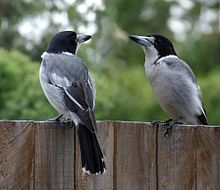Butcherbird
| Butcherbirds | |
|---|---|
 |
|
| Two grey butcherbirds | |
| Scientific classification | |
| Kingdom: | Animalia |
| Phylum: | Chordata |
| Class: | Aves |
| Order: | Passeriformes |
| Suborder: | Passeri |
| Family: | Artamidae |
| Genera | |
|
Melloria |
|
Melloria
Cracticus
Butcherbirds are magpie-like birds, most found in the genus Cracticus, but the black butcherbird is placed in the monotypic genus Melloria. They are native to Australasia. The Australian magpie has recently been placed in the same genus, and this new taxonomy has been supported by recent phylogenetic analyses. Together with three species of currawong and two species of peltops, butcherbirds and the Australian magpie form the subfamily Cracticinae in the family Artamidae.
Butcherbirds are large songbirds, being between 30 and 40 cm (12–16 in) in length. Their colour ranges from black-and-white to mostly black with added grey plumage, depending on the species. They have a large, straight bill with a distinctive hook at the end which is used to skewer prey. They have high-pitched complex songs, which are used to defend their essentially year-round group territories: unlike birds of extratropical Eurasia and the Americas, both sexes sing prolifically.
Butcherbirds are insect eaters for the most part, but will also feed on small lizards and other vertebrates. They get their name from their habit of impaling captured prey on a thorn, tree fork, or crevice. This "larder" is used to support the victim while it is being eaten, to store prey for later consumption, or to attract mates.
Butcherbirds are the ecological counterparts of the shrikes, which are only distantly related, but share the "larder" habit; shrikes are also sometimes called "butcherbirds". Butcherbirds live in a variety of habitats from tropical rainforest to arid shrubland. Like many similar species, they have adapted well to urbanisation and can be found in leafy suburbs throughout Australia. They are opportunistic, showing little fear and readily taking food offerings to the point of becoming semi-tame.
...
Wikipedia
